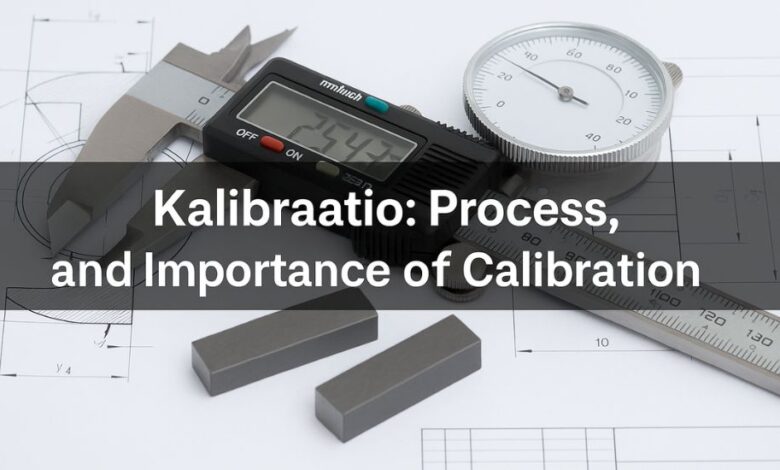Kalibraatio: Meaning, Process, and Importance of Calibration

Kalibraatio, the Finnish term for calibration, is a fundamental process in science, engineering, and industry. Calibration ensures that the instruments or devices we rely on for measurement provide accurate and reliable readings. Whether in a laboratory, a hospital, a manufacturing plant, or a safety inspection site, calibration forms the backbone of precision, compliance, and quality assurance. This article will explore Kalibraatio in depth, covering its definition, significance, processes, types, and benefits, along with common misconceptions and best practices.
What Is Kalibraatio?
The term Kalibraatio refers to the comparison of a measuring instrument or device with a known reference standard to determine its accuracy. If discrepancies are found, adjustments may be made to bring the instrument back into alignment with the reference. In metrology, calibration is a traceable process, meaning that the reference standard itself is verified against a higher-level standard, often maintained by a national or international metrology institute.
In simple terms:
-
Kalibraatio = Checking and adjusting instruments to ensure they measure correctly.
-
Examples: Calibrating a weighing scale, a thermometer, a pressure gauge, or a laboratory spectrometer.
Importance of Kalibraatio in Modern Industries
-
Ensures Accuracy and Reliability
Without calibration, instruments can drift over time, leading to inaccurate measurements. For instance, a miscalibrated thermometer in a food processing plant could risk health and safety. -
Supports Quality Control
In manufacturing, even small deviations can lead to defective products. Regular Kalibraatio ensures consistency in production and maintains high quality standards. -
Regulatory and Compliance Requirements
Many industries must adhere to strict regulations like ISO 9000 or ISO/IEC 17025, which mandate traceable calibration. Non-compliance can lead to penalties, recalls, or reputational damage. -
Enhances Safety
Incorrect readings from uncalibrated instruments can have severe consequences, particularly in medical, aviation, or chemical environments. Proper calibration minimizes such risks. -
Reduces Costs and Waste
Accurate instruments prevent rework, material wastage, and operational inefficiencies, saving companies significant resources in the long run.
Key Components of the Kalibraatio Process
-
Comparison
-
The device under test (DUT) is compared against a more accurate reference standard.
-
This reference standard is itself calibrated and certified.
-
-
Traceability
-
Calibration results must be traceable to international or national standards, creating an unbroken chain of accuracy verification.
-
-
Uncertainty Measurement
-
Every calibration result includes a degree of uncertainty—no measurement is perfectly exact, but calibration minimizes possible errors.
-
-
Adjustment (If Required)
-
While calibration itself is a comparison process, devices often undergo adjustment to correct deviations detected during the process.
-
Results are recorded as “As Found” (before adjustment) and “As Left” (after adjustment).
-
-
Certification and Documentation
-
A calibration certificate includes the device details, calibration method, environmental conditions, measurement results, and overall pass/fail status.
-
Types of Kalibraatio
-
Single-Point Calibration
-
Checks the instrument at one point only; used when a single critical measurement is sufficient.
-
-
Multi-Point Calibration
-
Evaluates multiple measurement points across the instrument’s operating range, providing better insight into its accuracy.
-
-
Manual Calibration
-
Requires skilled personnel to adjust instruments using standard tools and procedures.
-
-
Automated Calibration
-
Used in high-tech environments; advanced devices automatically compare readings and record data for efficiency.
-
When and How Often Should Kalibraatio Be Done?
Calibration intervals vary by device type, industry, and usage. Common scenarios include:
-
Periodic Schedules: Every 6–12 months, as recommended by manufacturers.
-
Post-Event Calibration: After transportation, accidental shock, or extreme temperature exposure.
-
Pre-Critical Measurement: Before audits, product releases, or research projects.
-
Based on Historical Trends: Devices showing minimal drift may allow longer intervals, while unstable devices need frequent checks.
Benefits of Regular Kalibraatio
-
Improved Measurement Confidence: Users can trust the readings of their instruments.
-
Regulatory Compliance: Avoids penalties and ensures certification during audits.
-
Enhanced Safety: Reduces the risk of accidents caused by faulty readings.
-
Increased Efficiency: Minimizes rework and production downtime.
-
Long-Term Cost Savings: Prevents waste of materials and resources.
Common Misconceptions About Kalibraatio
-
“Calibration Is One-Time Only”
-
Instruments drift over time. Calibration is a continuous, cyclical process.
-
-
“Only High-Tech Equipment Needs Calibration”
-
Even simple devices like kitchen scales or thermometers require periodic checks.
-
-
“Calibration Is Too Expensive”
-
The cost of an uncalibrated instrument causing a production error or safety issue is far higher.
-
-
“Anyone Can Calibrate”
-
Proper calibration requires trained personnel and traceable standards to be valid.
-
Step-by-Step Example of a Kalibraatio Process
-
Identify the device requiring calibration (e.g., a digital scale).
-
Compare its readings with a reference weight certified by a national metrology institute.
-
Record the results as As Found to note the initial error.
-
Adjust the scale if deviations exceed the permissible tolerance.
-
Repeat the measurement and document the As Left readings.
-
Issue a calibration certificate including traceability and uncertainty information.
Conclusion
Kalibraatio is far more than a technical formality—it is the foundation of measurement accuracy, safety, and quality across countless industries. From laboratories and hospitals to factories and aviation, calibration ensures that the instruments we trust deliver precise and reliable results. Regular calibration not only meets regulatory requirements but also prevents costly errors, enhances safety, and supports efficient operations. In today’s world, where accuracy is non-negotiable, Kalibraatio remains a key pillar of modern technology and industry.
Article published on my blog site Mating Press.


